The EUR/USD pair has been steadily climbing for the past six days, reaching around 1.0830 during the Asian session on Tuesday. This upward trend comes as a surprise to many, especially after France’s election results. A leftist alliance unexpectedly took the lead, preventing Marine Le Pen’s far-right party from dominating the leadership race. This unexpected turn of events has caused a stir in the market, but investors seem to be digesting the news well as the Euro continues to advance.
Federal Reserve Chairman Jerome Powell is set to deliver “The Semi-annual Monetary Policy Report” to the US Congress on Tuesday. This report is highly anticipated as it could provide insight into the Fed’s stance on interest rates. Traders are speculating that soft US employment data may prompt the Fed to consider reducing interest rates come September. The CME’s FedWatch Tool indicates a 76.2% probability of a rate cut in September, up from 65.5% just a week earlier. Powell’s remarks to Congress could shed light on the Fed’s future monetary policy decisions.
Market Impact and Currency Analysis
The Euro, as the currency for 20 European Union countries belonging to the Eurozone, is the second most heavily traded currency in the world, behind the US Dollar. In 2022, it accounted for 31% of all foreign exchange transactions, with an average daily turnover exceeding $2.2 trillion. The most traded currency pair in the world is the EUR/USD, representing approximately 30% of all transactions. Other significant pairs include EUR/JPY (4%), EUR/GBP (3%), and EUR/AUD (2%).
The European Central Bank (ECB), located in Frankfurt, Germany, is the reserve bank for the Eurozone. It is responsible for setting interest rates and managing monetary policy. The ECB aims to maintain price stability by controlling inflation or stimulating growth through interest rate adjustments. Decision-making is carried out by the ECB Governing Council, which meets eight times a year and includes heads of Eurozone national banks and six permanent members, such as ECB President Christine Lagarde.
Key economic indicators such as GDP, Manufacturing and Services PMIs, employment figures, and consumer sentiment surveys play a crucial role in influencing the direction of the Euro. A strong economy attracts foreign investment and may lead to interest rate hikes, strengthening the Euro. Conversely, weak economic data can weigh down the Euro. Data releases from major Eurozone economies, including Germany, France, Italy, and Spain, are closely monitored as they represent 75% of the Eurozone’s GDP.
The Trade Balance is another essential indicator for the Euro. It measures the difference between a country’s exports and imports over a specific period. A positive net Trade Balance, driven by high-demand exports, can strengthen a currency by attracting foreign buyers and increasing demand. On the other hand, a negative balance can weaken a currency. A strong economy and positive trade balance are typically favorable for the Euro’s performance in global markets.
The rise of the EUR/USD pair amidst unexpected political developments and monetary policy speculation reflects the interconnectedness of global markets. Traders and investors will closely monitor upcoming data releases and statements from central banks for further insights into the future direction of the Euro and its impact on the broader financial landscape.

